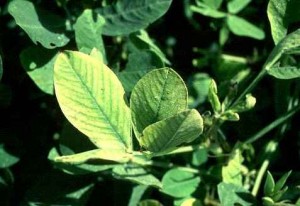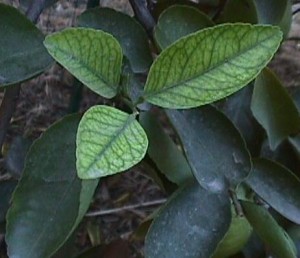San Antonio Express News
GARDENING, Etc.
Sunday, May 25, 2003
By Lynn Rawe
What’s wrong with my plants? They’re yellowing and I don’t know what to do! This is one of the most commonly asked questions concerning plants grown in alkaline soils. Before the problem can be solved, there are a few things one must know.
Yellowing leaves could be the symptoms of a couple of problems. If the entire leaf is yellow, the problem could be nitrogen. In severe cases of iron deficiency, the entire leaf could be yellow, too. The way to determine whether it is iron or nitrogen is by looking at the location of the yellowing leaves. Iron deficiency occurs on the new growth, toward the tips. Nitrogen occurs from the bottom of the plant on the old growth.
The symptoms of iron deficiency, also known as iron chlorosis, appear in the leaves as green veins and yellow leaf tissue. If the deficiency is severe, the entire leaf may become yellow. Lastly, brown edges may begin to show up. Also in severe cases, chlorosis can progress to older growth in the plant.
Iron chlorosis is found where soils are highly alkaline. The high pH of the soil ties up the iron in the soil, making it unavailable to the plants. Iron is required for the formation of chlorophyll in plant cells and serves as an activator for respiration and photosynthesis. High soil temperatures and high light intensity can also increase problems with iron chlorosis.
Some plants are more prone to iron chlorosis than others. Red tip photinia, a commonly used plant for hedges often shows symptoms of iron deficiency. Other plants such as Indian hawthorn, pine trees, and even St. Augustine grass may have problems with alkaline soils and iron chlorosis.
Now that you know what this problem is, how do you solve it? Applying iron is the answer, but you should know what type to use. If your plant has a severe problem and you need a quick fix, applying liquid iron will work for a short period of time. Liquid iron is most effective used as a foliar spray.
Chelated iron is the best solution and last the longest. There are several formulations of chelated iron. Different types of chelating agents are used and are designated as EDDHMA, EDDHA, HEDTA, DTPA and EDTA. The type of chelating agent recommended depends mainly on the pH value of the soil. In soil application EDDHA and EDDHMA are preferable chelating agents for ensuring iron availability in alkaline soils. Chelates of HEDTA, DTPA and EDTA are effective in less alkaline or slightly acidic soils. The most common chelating agent is EDTA. Chelated irons are more expensive but last much longer. They can be found in liquid, powder or granular forms. The powder form is the most common. Sequestrine by Sprint, Dissolvine, Ferion, and Ferriplus are common brands that can be found in nurseries and garden centers. Different agents will have different percentages of iron in the product. Read the label carefully before apply any product to your lawn or plants.
Apply iron products at the drip line of trees and shrubs. This is the area that plants take up nutrients and water from their roots. Always avoid getting any type of iron product on sidewalks, patios, driveways or brick. Residue from these products will leave stains that are difficult, if not impossible to remove.
This article was written by Lynn Rawe, Extension Agent – Horticulture, Texas Cooperative Extension in Bexar County.

